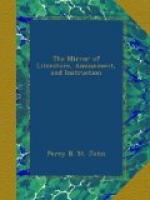THE MIRROR OF LITERATURE, AMUSEMENT, AND INSTRUCTION.
Vol. 14, No. 403.] Saturday, December 5, 1829. [Price 2d.
* * * * *
Fall of the Staubbath.
[Illustration: Fall of the Staubbath.]
In the poet and the philosopher, the lover of the sublime, and the student of the beautiful in art—the contemplation of such a scene as this must awaken ecstatic feelings of admiration and awe. Its effect upon the mere man of the world, whose mind is clogged up with common-places of life, must be overwhelming as the torrent itself; perchance he soon recovers from the impression; but the lover of Nature, in her wonders, reads lessons of infinite wisdom, combined with all that is most fascinating to the mind of inquiring man. In the school of her philosophy, mountains, rivers, and falls not only astonish and delight him in their vast outlines and surfaces, but in their exhaustless varieties and transformations, he enjoys old and new worlds of knowledge, apart from the proud histories of man, and the comparative insignificance of all that he has laboured to produce on the face of the globe.
Few have witnessed the Staubbach, or similar wonders without acknowledging the force of their impressions. This Fall is in the valley of Lauterbrun, the most picturesque district of Switzerland. Simond,[1] in describing its beauties, says, “we began to ascend the valley of Lauterbrun, by the side of its torrent (the Lutschine) among fragments of rocks, torn from the heights on both sides, and beautiful trees, shooting up with great luxuriance and in infinite variety; smooth pastures of the richest verdure, carpeted over every interval of plain ground; and the harmony of the sonorous cow-bell of the Alps, heard among the precipices above our heads and below us, told us we were not in a desart.” “The ruins of the mineral world, apparently so durable, and yet in a state of incessant decomposition, form a striking contrast with the perennial youth of the vegetable world; each individual plant, so frail and perishable, while the species is eternal in the existing economy of nature. Imperceptible forests of timber scarcely tinge their inert masses of gneiss and granite, into which they anchor their roots; grappling with substances which, when struck with steel, tear up the tempered grain, and dash out the spark.” This may be an enthusiastic, but is doubtless the faithful, impression of our tourist; and in descriptions of sublime nature, we should
Survey the whole; nor seek slight fault
to find,
Where Nature moves, and rapture warms
the mind.
[1] Switzerland; or a Journal
of a Tour and Residence in that
country,
in 1817, 1818, and 1819. By L. Simond, 2 vols.
8 vo.
Second
Edit. 1823 Murray.
Each valley has its appropriate stream, proportioned to its length, and the number of lateral valleys opening into it. The boisterous Lutschine is the stream of Lauterbrun, and it carries to the Lake of Brientz scarcely less water than the Aar itself. About half way between Interlaken and Lauterbrun, is the junction of the two Lutschines, the black and the white, from the different substances with which they have been in contact.




